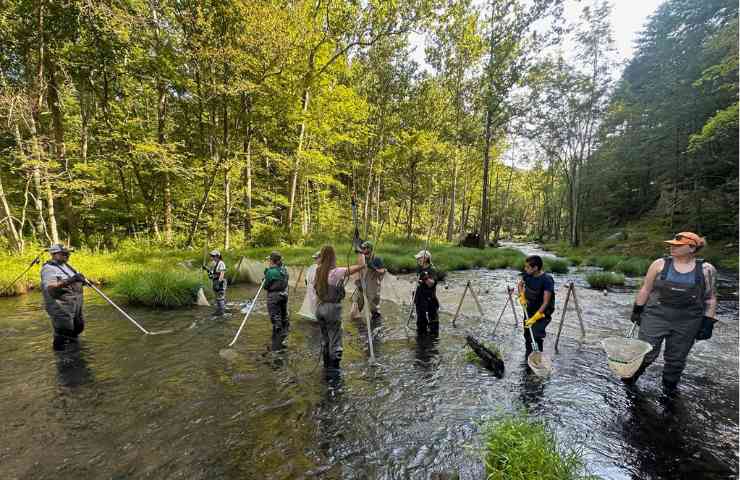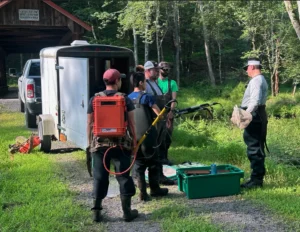This past July, The Ashokan Center partnered with the New York State Department of Environmental Conservation (DEC) and Catskill Mountains Trout Unlimited for an electrofishing survey of the Lower Esopus Creek, a vital waterway flowing through Ashokan’s 385-acre campus. The research helps scientists better understand fish populations, water quality, and stream health in this ecologically significant Catskill watershed.
What Is Electrofishing?
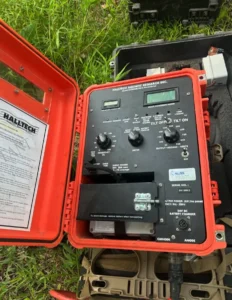 Electrofishing is a research method that temporarily stuns fish using a mild electric current, allowing biologists to collect, identify, and measure them before safely releasing them back into the water. This approach provides valuable data about species diversity, age classes, and habitat conditions without causing long-term harm to the fish or ecosystem.
Electrofishing is a research method that temporarily stuns fish using a mild electric current, allowing biologists to collect, identify, and measure them before safely releasing them back into the water. This approach provides valuable data about species diversity, age classes, and habitat conditions without causing long-term harm to the fish or ecosystem.
At Ashokan, the DEC team used a small generator-powered unit connected to handheld wands, which created a controlled current in a 100-yard stretch of the stream. By collecting, identifying, and releasing fish within this section, researchers were able to estimate population densities and assess the overall health of the aquatic community.
Why It Matters
According to Stuart Leigh, who participated in the study, this year’s survey was the first comprehensive fish population analysis conducted in the upper reaches of the Lower Esopus Creek (above Hurley Mountain Road) in many years.
“The goal was to update our understanding of current conditions and establish a baseline for future studies,” Leigh explained. “We also wanted to clarify how this stretch of the creek should be classified under state standards—whether it supports trout, or trout spawning populations.”
This classification is important because it determines the level of environmental protection the stream receives. Streams that support trout spawning (classified “TS”) are considered high-value habitats and are granted additional safeguards.
What the Survey Found
The Ashokan Center site—located just below the reservoir—had the coldest water temperature of the three surveyed locations: a refreshing 60.8°F. Cold water is critical for trout survival, and the results confirmed that Ashokan’s section of the creek supports strong, healthy populations of both brown and rainbow trout, including many young-of-the-year (YOY) fish, a key indicator of active spawning.
Preliminary counts included:
-
Brown trout: 55 adult, 77 YOY
-
Rainbow trout: 36 adult, 57 YOY
-
Blacknose dace: 44
-
Cutlips minnow: 14
-
Longnose dace: 13
-
Creek chub: 3
-
Yellow perch: 1
-
Log perch: 1
Downstream, where the water was warmer (up to 74°F), trout were far less common—demonstrating how temperature strongly influences which species can thrive in different parts of the creek.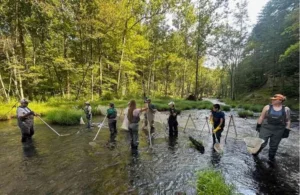
Connecting to Broader Conservation Work
This research complements other ongoing DEC projects, including a water quality study in Marbletown aimed at identifying potential sources of bacterial pollution in the Lower Esopus. Together, these efforts provide a clearer picture of how reservoir releases, land use, and temperature patterns impact fish and water health across the watershed.
Leigh emphasized the importance of carefully managed water releases from the Ashokan Reservoir:
“The DEP’s community releases are what have allowed these trout populations to exist and thrive here,” he said. “It’s encouraging to see such strong numbers of spawning trout just below the Mill Dam—but higher minimum release flows could further enhance habitat quality all along the Lower Esopus.”
Stewardship in Action
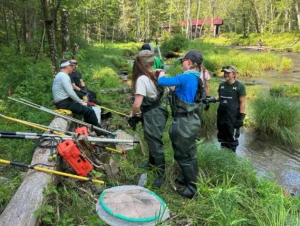 At The Ashokan Center, partnerships like this one illustrate our commitment to hands-on environmental education and scientific collaboration. Every study deepens our understanding of the living systems around us—and helps protect the land and waters that inspire our programs in nature, history, music, and art.
At The Ashokan Center, partnerships like this one illustrate our commitment to hands-on environmental education and scientific collaboration. Every study deepens our understanding of the living systems around us—and helps protect the land and waters that inspire our programs in nature, history, music, and art.
“It’s a privilege to host this kind of meaningful research on our campus,” said Molly Mason of the Ashokan Center. “Our connection with the DEC reminds students and visitors alike that stewardship and science go hand in hand.”
Photos and video of the electrofishing survey were provided by Stuart Leigh and the DEC Fisheries Management and Research Department.
To learn more about the Ashokan Center’s environmental programs or to book a school field trip, visit ashokancenter.org.

